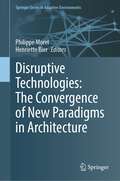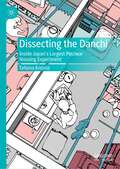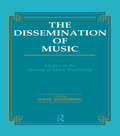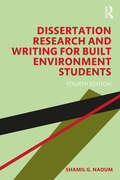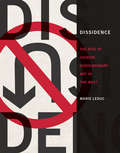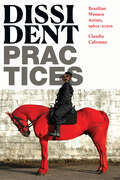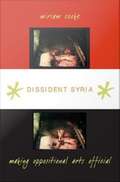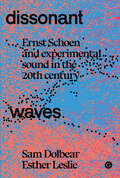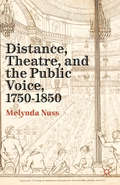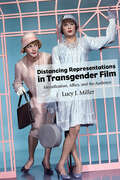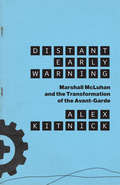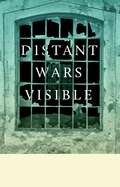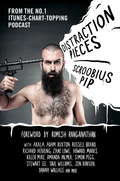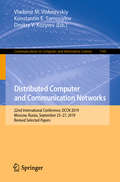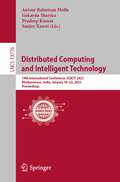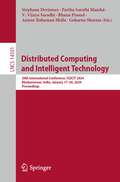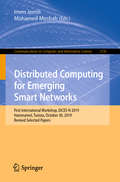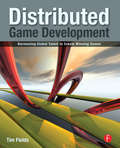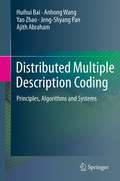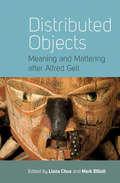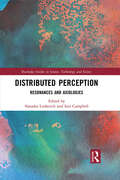- Table View
- List View
Disruptive Technologies: The Convergence of New Paradigms in Architecture (Springer Series in Adaptive Environments)
by Henriette Bier Philippe MorelThrough a series of highly speculative contributions by both leading and highly acclaimed practitioners and theorists, this book gives a new comprehensive overview of architectures’ most recent practical and theoretical developments. While a few chapters are mostly dedicated to a historical analysis of how we got to experience a new technological reality in architecture and beyond, all chapters including the most forward looking, have in common their rigorous understanding of history as a pool of radical experiments, whether one speaks of the history of architecture, or of sociology, technology, and science. Disruptive Technologies: The Convergence of New Paradigms in Architecture is required reading for anybody student, practitioner, and educator who wants to do serious research in architecture and all disciplines dealing with the shaping of our environment, beyond the important but restricted domain of computational architectural design.Additional multimedia content via app: download the SN More Media app for free, scan a link with play button and access to the Additional Contents directly on your smartphone or tablet.
Dissecting the Danchi: Inside Japan’s Largest Postwar Housing Experiment
by Tatiana KnorozThe book is the first to explore the history and political significance of the Japanese public housing program. In the 1960s, as Japan's postwar economy boomed, architects and urban planners inspired equally by Western modernism and Soviet ideas of housing as a basic right created new cityscapes to house populations turned into refugees by the war. Over time, as Japan's society aged and the economy began to stagnate, these structures have become a burden on society. In this closely researched monograph on the conditions of Japanese housing, Tatiana Knoroz sheds unexpected light on the rise and fall of the idea of social democracy in Japan which will be of interest to historians, architects, and scholars of Asian economic modernization.
Dissemination of Music: Studies in the History of Music Publishing (Musicology #14)
by Hans LennebergFirst Published in 1995. Routledge is an imprint of Taylor & Francis, an informa company.
Dissertation Research and Writing for Built Environment Students
by Shamil G. NaoumDissertation Research and Writing for Built Environment Students is a step-by-step guide to get students through their final year research project. Trusted and developed over three previous editions, the new fourth edition shows you how to select a dissertation topic, write a proposal, conduct a literature review, select the research approach, gather the data, analyse and present the information and ultimately produce a well-written dissertation. The book simplifies dissertation research and writing into a process involving a sequence of learnable activities and divides the process into three parts. Part One covers the necessary groundwork, including: identifying the problem, writing a proposal and reviewing the literature. Part Two covers the research design and includes: approaches and techniques for data collection and constructing and sampling a questionnaire. Part Three covers: measurement of data, analysis of data with SPSS, structuring and writing the whole dissertation, and supervision and assessment. This new edition is packed with updated examples and research samples, making this the ideal resource for students involved in research in built environment subjects such as construction management, construction project management, facilities management, real estate, building surveying, quantity surveying and civil engineering.
Dissidence: The Rise of Chinese Contemporary Art in the West
by Marie LeducHow the valorization of artistic and political dissidence has contributed to the rise of Chinese contemporary art in the West. Interest in Chinese contemporary art increased dramatically in the West shortly after the 1989 Tiananmen Square protests. Sparked by political sympathy and the mediatized response to the event, Western curators, critics, and art historians were quick to view the new art as an expression of dissident resistance to the Chinese regime. In this book, Marie Leduc proposes that this attribution of political dissidence is not only the result of latent Cold War perceptions about China, but also indicative of the art world's demand for artistically and politically provocative work—a demand that mirrors the valorization of free expression in liberal democracies. Focusing on nine Chinese artists—Wang Du, Wang Keping, Huang Yong Ping, Yang Jiechang, Chen Zhen, Yan Pei-Ming, Shen Yuan, Ru Xiaofan, and Du Zhenjun—who migrated to Paris in and around 1989, Leduc explores how their work was recognized before and after the Tiananmen Square incident. Drawing on personal interviews with the artists and curators, and through an analysis of important exhibitions, events, reviews, and curatorial texts, she demonstrates how these and other Chinese artists have been celebrated both for their artistic dissidence—their formal innovations and introduction of new media and concepts—and for their political dissidence—how their work challenges political values in both China and the West. As Leduc concludes, the rise of Chinese contemporary art in the West highlights the significance of artistic and political dissidence in the production of contemporary art, and the often-unrecognized relationship between contemporary art and liberal democracy.
Dissident Practices: Brazilian Women Artists, 1960s–2020s
by Claudia CalirmanIn Dissident Practices, Claudia Calirman examines sixty years of visual art by prominent and emerging Brazilian women artists from the 1960s to the present, covering the period from the military dictatorship to the return to democracy in the mid-1980s, the social changes of the 2000s, the rise of the Right in the late-2010s, and the recent development of an overtly feminist art practice. Though they were lauded as key figures in Brazilian art, these artists still faced adversity and constraints because of their gender. Although many of them in the 1960s and 1970s disavowed the term feminism, Calirman gives a nuanced account of how they responded to authoritarianism, engaged with trauma in the aftermath of the military dictatorship, interrogated social gender norms, and fought against women’s objectification. By battling social inequalities, structures of power, and state violence, these artists create political agency in a society in which women remain targets of brutality and discrimination.
Dissident Syria: Making Oppositional Arts Official
by Miriam CookeFrom 1970 until his death in 2000, Hafiz Asad ruled Syria with an iron fist. His regime controlled every aspect of daily life. Seeking to preempt popular unrest, Asad sometimes facilitated the expression of anti-government sentiment by appropriating the work of artists and writers, turning works of protest into official agitprop. Syrian dissidents were forced to negotiate between the desire to genuinely criticize the authoritarian regime, the risk to their own safety and security that such criticism would invite, and the fear that their work would be co-opted as government propaganda, as what miriam cooke calls "commissioned criticism. " In this intimate account of dissidence in Asad's Syria, cooke describes how intellectuals attempted to navigate between charges of complicity with the state and treason against it. A renowned scholar of Arab cultures, cooke spent six months in Syria during the mid-1990s familiarizing herself with the country's literary scene, particularly its women writers. While she was in Damascus, dissidents told her that to really understand life under Hafiz Asad, she had to speak with playwrights, filmmakers, and, above all, the authors of "prison literature. " She shares what she learned in Dissident Syria. She describes touring a sculptor's studio, looking at the artist's subversive work as well as at pieces commissioned by the government. She relates a playwright's view that theater is unique in its ability to stage protest through innuendo and gesture. Turning to film, she shares filmmakers' experiences of making movies that are praised abroad but rarely if ever screened at home. Filled with the voices of writers and artists, Dissident Syria reveals a community of conscience within Syria to those beyond its borders.
Dissonant Waves: Ernst Schoen and Experimental Sound in the 20th century (Goldsmiths Press / Sonics Series)
by Esther Leslie Sam DolbearAn investigation of the cultures and technologies of early radio and how a generation of cultural operators—with Schoen at the center—addressed crisis and adversity.Dials, knobs, microphones, clocks; heads, hands, breath, voices. Ernst Schoen joined Frankfurt Radio in the 1920s as programmer and accelerated the potentials of this collision of bodies and technologies. As with others of his generation, Schoen experienced crisis after crisis, from the violence of war, the suicide of friends, economic collapse, and a brief episode of permitted experimentalism under the Weimar Republic for those who would foster aesthetic, technical, and political revolution. The counterreaction was Nazism—and Schoen and his milieux fell victim to it, found ways out of it, or hit against it with all their might.Dissonant Waves tracks the life of Ernst Schoen—poet, composer, radio programmer, theorist, and best friend of Walter Benjamin from childhood—as he moves between Frankfurt, Berlin, Paris, and London. It casts radio history and practice into concrete spaces, into networks of friends and institutions, into political exigencies and domestic plights, and into broader aesthetic discussions of the politicization of art and the aestheticization of politics. Through friendship and comradeship, a position in state-backed radio, imprisonment, exile, networking in a new country, re-emigration, ill-treatment, neglect, Schoen suffers the century and articulates its broken promises.An exploration of the ripples of radio waves, the circuits of experimentation and friendship, and the proposals that half-found a route into the world—and might yet spark political-technical experimentation.
Distance, Theatre, and the Public Voice, 1750–1850
by M. NussAs theatres expanded in the eighteenth and nineteenth centuries, the distance between actor and audience became a telling metaphor for the distance emerging between writers and readers. Nuss explores the ways in which theatre helped authors imagine connecting with a new mass audience.
Distancing Representations in Transgender Film: Identification, Affect, and the Audience (SUNY series, Horizons of Cinema)
by Lucy J. MillerDistancing Representations in Transgender Film explores the representation of transgender identity in several important cinema genres: comedies, horror films, suspense thrillers, and dramas. In a critique that is both deeply personal and theoretically sophisticated, Lucy J. Miller examines how these representations are often narratively and visually constructed to prompt emotions of ridicule, fear, disgust, and sympathy from a cisgender audience. Created by and for cisgender people, these films do not accurately represent transgender people's experiences, and the emotions they inspire serve to distance cisgender audience members from the transgender people they encounter in their day-to-day lives. By helping to increase the distance between cisgender and transgender people, Miller argues, these films make it more difficult for cisgender people to understand the experiences of transgender people and for transgender people to fully participate in public life. The book concludes with suggestions for improving transgender representation in film.
Distant Early Warning: Marshall McLuhan and the Transformation of the Avant-Garde
by Alex KitnickMarshall McLuhan (1911–1980) is best known as a media theorist—many consider him the founder of media studies—but he was also an important theorist of art. Though a near-household name for decades due to magazine interviews and TV specials, McLuhan remains an underappreciated yet fascinating figure in art history. His connections with the art of his own time were largely unexplored, until now. In Distant Early Warning, art historian Alex Kitnick delves into these rich connections and argues both that McLuhan was influenced by art and artists and, more surprisingly, that McLuhan’s work directly influenced the art and artists of his time. Kitnick builds the story of McLuhan’s entanglement with artists by carefully drawing out the connections among McLuhan, his theories, and the artists themselves. The story is packed with big names: Marcel Duchamp, Niki de Saint Phalle, Jasper Johns, Andy Warhol, Nam June Paik, and others. Kitnick masterfully weaves this history with McLuhan’s own words and his provocative ideas about what art is and what artists should do, revealing McLuhan’s influence on the avant-garde through the confluence of art and theory. The illuminating result sheds light on new aspects of McLuhan, showing him not just as a theorist, or an influencer, but as a richly multifaceted figure who, among his many other accolades, affected multiple generations of artists and their works. The book finishes with Kitnick overlaying McLuhan’s ethos onto the state of contemporary and post-internet art. This final channeling of McLuhan is a swift and beautiful analysis, with a personal touch, of art’s recent transgressions and what its future may hold.
Distant Early Warning: Marshall McLuhan and the Transformation of the Avant-Garde
by Alex KitnickMarshall McLuhan (1911–1980) is best known as a media theorist—many consider him the founder of media studies—but he was also an important theorist of art. Though a near-household name for decades due to magazine interviews and TV specials, McLuhan remains an underappreciated yet fascinating figure in art history. His connections with the art of his own time were largely unexplored, until now. In Distant Early Warning, art historian Alex Kitnick delves into these rich connections and argues both that McLuhan was influenced by art and artists and, more surprisingly, that McLuhan’s work directly influenced the art and artists of his time. Kitnick builds the story of McLuhan’s entanglement with artists by carefully drawing out the connections among McLuhan, his theories, and the artists themselves. The story is packed with big names: Marcel Duchamp, Niki de Saint Phalle, Jasper Johns, Andy Warhol, Nam June Paik, and others. Kitnick masterfully weaves this history with McLuhan’s own words and his provocative ideas about what art is and what artists should do, revealing McLuhan’s influence on the avant-garde through the confluence of art and theory. The illuminating result sheds light on new aspects of McLuhan, showing him not just as a theorist, or an influencer, but as a richly multifaceted figure who, among his many other accolades, affected multiple generations of artists and their works. The book finishes with Kitnick overlaying McLuhan’s ethos onto the state of contemporary and post-internet art. This final channeling of McLuhan is a swift and beautiful analysis, with a personal touch, of art’s recent transgressions and what its future may hold.
Distant Early Warning: Marshall McLuhan and the Transformation of the Avant-Garde
by Alex KitnickMarshall McLuhan (1911–1980) is best known as a media theorist—many consider him the founder of media studies—but he was also an important theorist of art. Though a near-household name for decades due to magazine interviews and TV specials, McLuhan remains an underappreciated yet fascinating figure in art history. His connections with the art of his own time were largely unexplored, until now. In Distant Early Warning, art historian Alex Kitnick delves into these rich connections and argues both that McLuhan was influenced by art and artists and, more surprisingly, that McLuhan’s work directly influenced the art and artists of his time. Kitnick builds the story of McLuhan’s entanglement with artists by carefully drawing out the connections among McLuhan, his theories, and the artists themselves. The story is packed with big names: Marcel Duchamp, Niki de Saint Phalle, Jasper Johns, Andy Warhol, Nam June Paik, and others. Kitnick masterfully weaves this history with McLuhan’s own words and his provocative ideas about what art is and what artists should do, revealing McLuhan’s influence on the avant-garde through the confluence of art and theory. The illuminating result sheds light on new aspects of McLuhan, showing him not just as a theorist, or an influencer, but as a richly multifaceted figure who, among his many other accolades, affected multiple generations of artists and their works. The book finishes with Kitnick overlaying McLuhan’s ethos onto the state of contemporary and post-internet art. This final channeling of McLuhan is a swift and beautiful analysis, with a personal touch, of art’s recent transgressions and what its future may hold.
Distant Wars Visible: The Ambivalence of Witnessing (Critical American Studies)
by Wendy KozolIn our wired world, visual images of military conflict and political strife are ubiquitous. Far less obvious, far more elusive, is how we see such images, how witnessing military violence and suffering affects us. Distant Wars Visible brings a new perspective to such enduring questions about conflict photography and other forms of visual advocacy, whether in support of U.S. military objectives or in critique of the nation at war. At the book&’s center is what author Wendy Kozol calls an analytic of ambivalence—a critical approach to the tensions between spectacle and empathy provoked by gazing at military atrocities and trauma. Through this approach, Distant Wars Visible uses key concepts such as the politics of recoil, the notion of looking elsewhere, skeptical documents, and ethical spectatorship to examine multiple visual cultural practices depicting war, on and off the battlefield, from the 1999 NATO bombings in Kosovo to the present.Kozol&’s analysis draws from collections of family photographs, human rights photography, independent film production, photojournalism, and other examples of war&’s visual culture, as well as extensive visual evidence of the ways in which U.S. militarism operates to maintain geopolitical dominance—from Fallujah and Abu Ghraib to the most recent drone strikes in Pakistan. Throughout, Kozol reveals how factors such as gender, race, and sexuality construct competing visualizations of identity in a range of media from graphic narrative and film to conflict photography and battlefield souvenirs—and how contingencies and contradictions in visual culture shape the politics and ethics of witnessing.
Distraction Pieces
by Scroobius PipJoin Scroobius Pip as he gets to the bottom of what matters most in life: whether getting Russell Brand to expound on capitalism, Jon Ronson on the perils of social media, Simon Pegg on the power of satire, Killer Mike on race relations in the United States or Howard Marks on drugs and cancer, Pip elicits thought-provoking material by rummaging through the minds of some of the most interesting creatives of our time. Distraction Pieces features both curated highlights from the iTunes-chart-topping podcast - from Akala to Howard Marks via the likes of Adam Buxton, Romesh Ranganathan and Amanda Palmer - and exclusive new content, with chapters on politics, social media, music, comedy and more. Featuring illustrations by tattoo artist mr heggie, this is a must-have for fans of the Distraction Pieces podcast, and a must-read for anyone interested in the creative mind.
Distraction Pieces
by Scroobius PipThe Times Bestseller (Non-Fiction)Join Scroobius Pip as he gets to the bottom of what matters most in life: whether getting Russell Brand to expound on capitalism, Jon Ronson on the perils of social media, Simon Pegg on the power of satire, Killer Mike on race relations in the United States or Howard Marks on drugs and cancer, Pip elicits thought-provoking material by rummaging through the minds of some of the most interesting creatives of our time. Distraction Pieces features both curated highlights from the iTunes-chart-topping podcast - from Akala to Howard Marks via the likes of Adam Buxton, Romesh Ranganathan and Amanda Palmer - and exclusive new content, with chapters on politics, social media, music, comedy and more. Featuring illustrations by tattoo artist mr heggie, this is a must-have for fans of the Distraction Pieces podcast, and a must-read for anyone interested in the creative mind.
Distraction Pieces
by Scroobius PipThe Times Bestseller (Non-Fiction)Join Scroobius Pip as he gets to the bottom of what matters most in life: whether getting Russell Brand to expound on capitalism, Jon Ronson on the perils of social media, Simon Pegg on the power of satire, Killer Mike on race relations in the United States or Howard Marks on drugs and cancer, Pip elicits thought-provoking material by rummaging through the minds of some of the most interesting creatives of our time. Distraction Pieces features both curated highlights from the iTunes-chart-topping podcast - from Akala to Howard Marks via the likes of Adam Buxton, Romesh Ranganathan and Amanda Palmer - and exclusive new content, with chapters on politics, social media, music, comedy and more. Featuring illustrations by tattoo artist mr heggie, this is a must-have for fans of the Distraction Pieces podcast, and a must-read for anyone interested in the creative mind.
Distributed Computer and Communication Networks: 22nd International Conference, DCCN 2019, Moscow, Russia, September 23–27, 2019, Revised Selected Papers (Communications in Computer and Information Science #1141)
by Vladimir M. Vishnevskiy Konstantin E. Samouylov Dmitry V. KozyrevThis book constitutes the refereed proceedings of the 22nd International Conference on Distributed and Computer and Communication Networks, DCCN 2019, held in Moscow, Russia, in September 2019. The 50 full papers and 2 short papers were carefully reviewed and selected from 174 submissions. The papers cover the following topics: Computer and Communication Networks and Technologies, Analytical Modeling of Distributed Systems, and Distributed Systems Applications.
Distributed Computing and Intelligent Technology: 19th International Conference, ICDCIT 2023, Bhubaneswar, India, January 18–22, 2023, Proceedings (Lecture Notes in Computer Science #13776)
by Pradeep Kumar Anisur Rahaman Molla Gokarna Sharma Sanjay RawatThis book constitutes the proceedings of the 19th International Conference on Distributed Computing and Intelligent Technology, ICDCIT 2023, which was held in Bhubaneswar, India, in January 2023.The 20 full papers and 9 short papers presented in this volume were carefully reviewed and selected from 55 submissions. The papers are organized in the following topical sections: Invited Talks; Distributed Computing; Intelligent Technology.
Distributed Computing and Intelligent Technology: 20th International Conference, ICDCIT 2024, Bhubaneswar, India, January 17–20, 2024, Proceedings (Lecture Notes in Computer Science #14501)
by Bhanu Prasad Stéphane Devismes Anisur Rahaman Molla Gokarna Sharma Partha Sarathi Mandal V. Vijaya SaradhiThis book constitutes the refereed proceedings of the 20th International Conference on Distributed Computing and Intelligent Technology, ICDCIT 2024, which was held in Bhubaneswar, India, during January 17–20, 2024. The 24 full papers presented in this volume were carefully reviewed and selected from 116 submissions. The papers are organized in the following topical sections: Distributed Computing (DC) and Intelligent Technology (IT). The DC track solicits original research papers contributing to the foundations and applications of distributed computing, whereas the IT track solicits original research papers contributing to the foundations and applications of Intelligent Technology.
Distributed Computing for Emerging Smart Networks: First International Workshop, DiCES-N 2019, Hammamet, Tunisia, October 30, 2019, Revised Selected Papers (Communications in Computer and Information Science #1130)
by Mohamed Mosbah Imen JemiliThis book contains extended versions of the best papers presented at the First International Workshop on Distributed Computing for Emerging Smart Networks, DiCES-N 2019, held in Hammamet, Tunisia, in October 2019.The 9 revised full papers included in this volume were carefully reviewed and selected from 24 initial submissions. The papers are organized in the following topical sections: intelligent transportation systems; distributed computing for networking and communication; articial intelligence applied to cyber physical systems.
Distributed Game Development: Harnessing Global Talent to Create Winning Games
by Tim FieldsTake control of your global game development team and make successful AAA game titles using the 'Distributed Development' model. Game industry veteran Tim Fields teaches you how to evaluate game deals, how to staff teams for highly distributed game development, and how to maintain challenging relationships in order to get great games to market. This book is filled with interviews with a broad spectrum of industry experts from top game publishers and business owners in the US and UK. A supplementary web site provides interviews from the book, a forum where developers and publishers can connect, and additional tips and tricks. Topics include:
Distributed Multiple Description Coding
by Yao Zhao Huihui Bai Jeng-Shyang Pan Ajith Abraham Anhong WangThis book examines distributed video coding (DVC) and multiple description coding (MDC), two novel techniques designed to address the problems of conventional image and video compression coding. Covering all fundamental concepts and core technologies, the chapters can also be read as independent and self-sufficient, describing each methodology in sufficient detail to enable readers to repeat the corresponding experiments easily. Topics and features: provides a broad overview of DVC and MDC, from the basic principles to the latest research; covers sub-sampling based MDC, quantization based MDC, transform based MDC, and FEC based MDC; discusses Sleplian-Wolf coding based on Turbo and LDPC respectively, and comparing relative performance; includes original algorithms of MDC and DVC; presents the basic frameworks and experimental results, to help readers improve the efficiency of MDC and DVC; introduces the classical DVC system for mobile communications, providing the developmental environment in detail.
Distributed Objects
by Mark Elliott Liana ChuaOne of the most influential anthropological works of the last two decades, Alfred Gell's Art and Agency is a provocative and ambitious work that both challenged and reshaped anthropological understandings of art, agency, creativity and the social. It has become a touchstone in contemporary artifact-based scholarship. This volume brings together leading anthropologists, archaeologists, art historians and other scholars into an interdisciplinary dialogue with Art and Agency, generating a timely re-engagement with the themes, issues and arguments at the heart of Gell's work, which remains salient, and controversial, in the social sciences and humanities. Extending his theory into new territory - from music to literary technology and ontology to technological change - the contributors do not simply take stock, but also provoke, critically reassessing this important work while using it to challenge conceptual and disciplinary boundaries.
Distributed Perception: Resonances and Axiologies (Routledge Studies in Science, Technology and Society)
by Natasha LushetichContributors to this book include key theorists and practitioners from media theory, Native Science, bio-media and sound art, philosophy, art history and design informatics. Collectively, they examine the becoming-technique of animal-human- machinic perceptibilities; and micro-perceptions that lie beneath the threshold of known perceptions yet create energetic vibrations. Who, what, and where perceives, and how? What are the sedimentations, inscriptions and axiologies of animal, human and machinic perceptions? What are their perceptibilities? Deleuze uses the word ‘visibilities’ to indicate that visual perception isn’t just a physiological given but cues operations productive of new assemblages. Perceptibilities are, by analogy, spatio- temporal, geolocative, kinaesthetic, audio-visual, and haptic operations that are always already memory. In the case of strong inscriptions, they are also epigenetic events. The contributors show distributed perception to be a key notion in addressing the emergence and persistence of plant, animal, human and machine relations. An invaluable reference for students and scholars in a range of areas including Media Theory, Sociology, Philosophy, Art and Design.
